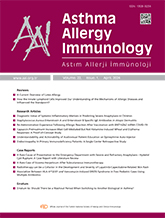


Innate lymphoid cells (ILCs) are immune effector cells involved in host defence against pathogens and have changed our perception of allergic dysregulation. Unlike T and B lymphocytes, the receptors of ILCs do not undergo somatic recombination during their development and do not have an antigen specific receptor. ILCs are similar to T cells in both their transcription and cytokine expression profiles and are classified into 3 subsets. They are thus considered to be the functional counterpart of T cells in innate immunity, and they are mainly localized in mucosal tissues rather than secondary lymphoid organs such as lymph nodes and spleen. It is known that ILCs play a role in the induction and regulation of inflammation through the various effector cytokines they secrete, and also in the pathogenesis of allergic diseases by accumulating in areas of allergic inflammation. In this review, the role of ILCs in allergic diseases and the effect of an allergic microenvironment on ILC plasticity will be discussed.